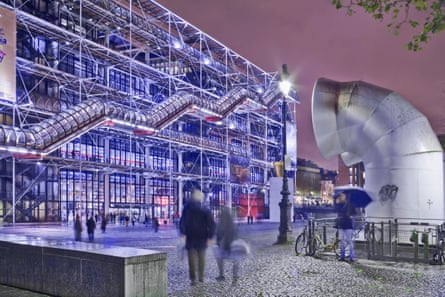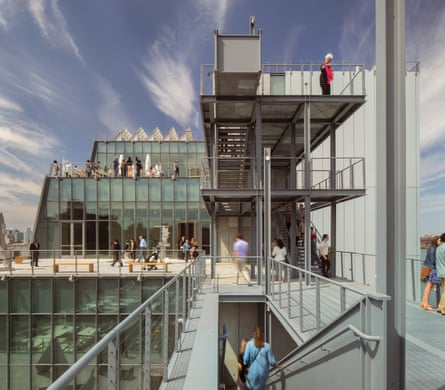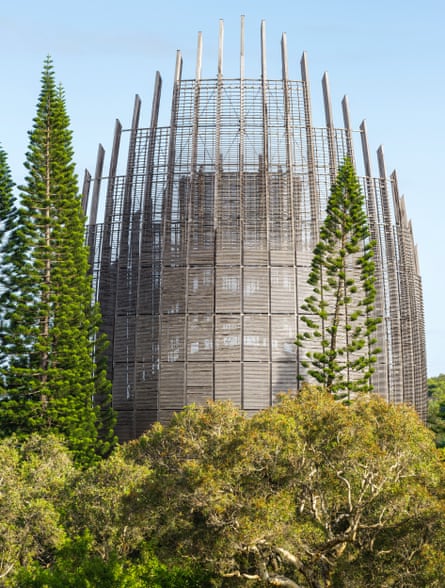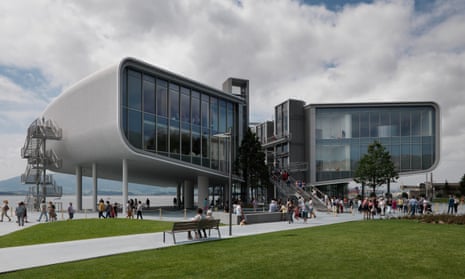In the short film within this exhibition, Renzo Piano recalls being taken to Genoa harbour by his father every Sunday after mass. As a child, Piano would marvel at the ships, which he likens to moving buildings. “That’s part of the reason my buildings are always flying vessels,” he says. His first design project was indeed a boat. He built it in his father’s garage, only to discover it was too big to get out – they had to break the garage doors.
Piano is hi-tech architecture’s high priest, renowned for buildings such as Paris’s Pompidou Centre, Kansai airport, the New York Times headquarters, the new Whitney Museum of American Art, and the Shard, London. His buildings are not always conspicuously visually “iconic” but this respectful exhibition brings home just how experimental the Italian architect’s career has been. The best of his work combines efficient, lightweight engineering and a love of putting materials together with a sense of social, even spiritual purpose. “You become an architect to change the world not to seduce,” he says, though it helps that he is thoughtful, cultured, softly spoken and charming.

The nautical influences were evident in Piano’s breakthrough “flying vessel”: the Pompidou Centre – still one of the most audacious structures in modern architecture, with its industrial, inside-out concept. Even in sketches here, it looks the stuff of sci-fi comics (by way of Archigram) rather than real life, but he clearly learned his lesson from the boat-in-the-garage episode: the Pompidou worked brilliantly, and still works. Piano was just 34 when he and Richard and Su Rogers won the design competition in 1971. The rest is history.
Two rooms of this exhibition are devoted to 16 of Piano’s “greatest hits”, each soberly presented on its own white, square table, neatly laid out with drawings, photographs and models. Larger models and mock-ups hang from the ceiling like natural history specimens: skeletal structural systems and rounded, sculptural forms.

That experimental boldness flows through the works – the heroic, 1.7km-long terminal of Kansai airport, built on an artificial island in Osaka Bay (it was recently flooded by Typhoon Jebi but is now reopening); the undulating grass roof of the California Academy of Sciences; the Menil Collection in Houston, Texas, whose curving concrete louvres control light and heat, and give the minimal building a distinctive identity. A fair few Piano buildings have divided opinion, such as the Shard (there are some planning documents on display here), and with more than 100 projects to his name, there are certainly a few bland and unloved Piano buildings out there – the garish Central St Giles Court in central London, for example – but there is no mention of those here.
In a third, darkened central room, Thomas Riedelsheimer’s 17-minute film – a relaxed conversation with the architect – plays on two walls. The centrepiece is a huge plywood model of an imaginary island, whose bays and hills and valleys are dotted with mored than 100 white plastic scale models of Piano’s works – a Pianotropolis, if you will. Aficionados can have fun playing “name that Piano”. The Shard is the size of a small candle, near the centre. His “Diogene” one-room cabin (situated at Vitra’s campus in Weil am Rhein in real life) I initially mistook for a stray speck of polystyrene.

For those familiar with his work, there is a wealth of depth and context to dive into here, illuminating Piano’s design process. However, novices might have to work harder to get a sense of the finished buildings. Architecture is always difficult to communicate within the confines of a gallery exhibition, and, if there’s a complaint with this one, it’s that knowledge of the finished buildings is assumed more than conveyed. There is some sensual colour in the form of discreet sound installations triggered by proximity – orchestral noises for the Parco della Musica concert hall, jet engines at Kansai airport – but many of the photographs are little bigger than postcards.
My personal favourite Piano building, for example, is the Jean-Marie Tjibaou Cultural Centre in Nouméa, New Caledonia, which I am never likely to see in real life. It is an evocative collection of beehive-like wooden pavilions, combining modern engineering and traditional building techniques, that seem to melt into the air as they rise (a recurring Piano trope). I came away with a sense of how it was made, but, despite the tropical bird sounds, not what it was like to be there.
On the upside, many of the artefacts from Piano’s studio are appreciable on their own merits. A component from the IBM Travelling Pavilion (another ahead-of-its-time structure) is a thing of beauty: a chunky, machined steel joint spliced into a curved strut of striped, laminated wood. Or best of all are the large-scale sections hand-drawn by longtime office member Shunji Ishida, which he has subtly populated with colleagues and famous figures. There’s Albert Einstein and Leonardo da Vinci in the longitudinal section of the IBM Travelling Pavilion, and there’s Claudio Abbado conducting the orchestra in the Parco della Musica, with Piano on cello.
One of Piano’s architectural tenets is that his often austere structures are animated by the human activity that takes place within them, but, apart from Piano’s presence in the film, that human element is sometimes lacking here. Visitors may have to provide it themselves.

Comments (…)
Sign in or create your Guardian account to join the discussion